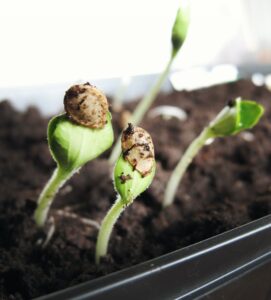Hello Fellow Readers, A few weeks ago, I heard from my high school sweetheart, who remains a lifelong friend. Rusty writes, “Sara is starting her hot pepper plants from seed this year. Is there effective plant grow lights that we should get? Many thanks.”
I sent a long-ago column with brief how-tos on using grow lights—the newer generation of the fluorescent kind on chains like my mom used to have. LED plant lights, new to me, are more efficient in many more ways than energy consumption. It’s complicated, but I’m shaking off my fear-resistance towards technology, so here goes—first, a bit of background on starting seeds.
Why you need plant grow lights to start seeds indoors:
 The rule of thumb of starting seeds indoors is eight weeks before the last frost date (typically May 19th in Northern NJ). So mid-March is our target. Perennials seeds are slower to germinate than annuals or vegetables taking up to a month to sprout, which justifies starting two weeks earlier. The Old Farmer’s Almanac has a nifty Frost Date Calculator where you can search frost dates for your area. (Link Below)
The rule of thumb of starting seeds indoors is eight weeks before the last frost date (typically May 19th in Northern NJ). So mid-March is our target. Perennials seeds are slower to germinate than annuals or vegetables taking up to a month to sprout, which justifies starting two weeks earlier. The Old Farmer’s Almanac has a nifty Frost Date Calculator where you can search frost dates for your area. (Link Below)
While you only need warmth and moisture to germinate seeds, they require light from above once they sprout. If the light source is too far away or from a window, plants will stretch towards the light and grow leggy. Also, baby plants need about 14 hours of sunlight per day, so daylight this time of the year is not long enough. Heat mats under seedlings help to ensure successful propagation and healthy roots.
On to the 101 of plant grow lights – LED vs. Fluorescent.
Dusting off the cobwebs from science class, you may recall the spectrums of light refracted through a prism are a rainbow of colors. Each has an individual frequency, wavelength, and energy that affect photosynthesis. The red and blue spectrums play the most significant role, and professional growers buy lights with only them. However, if you are growing in your living space, full-spectrum lamps are more pleasing.
If you have older fluorescent fixtures, they may not work with the more efficient LEDs. However, you can easily re-purpose newer good quality hood lights with T5 high-output bulbs with LED retrofit bars. I learned the iffy part is wattage, so check the fine print.
LEDs are mercury-free, don’t shatter like glass, last three times longer, and use less electricity. Another benefit is because LEDs are more efficient in providing higher outputs, you’ll likely need fewer bulbs. Higher output is not about brightness; it’s about intensity. The more efficient the bulb, the more photosynthetically active radiation (PAR) it provides. Listen to me, fancy-schmancy :^).
Plant grow lights can be pricey.
As a point of reference, my go-to Gardener Supply Catalog has a two-tier system with conventional T5 fluorescent bulbs for $289; the LED version costs $339, worth the extra. They have a 3-Tier LED Kit, which includes organic seed-starting supplies for $890.
Then there’s a stack and grow series, which is an excellent place to begin. A single light is $169 for fluorescent and $199 for LED. Sure, you can buy many starter plants for that, but the investment in grow lights lasts years. Regardless of which you use, if your starting seeds in rooms without windows, you’ll likely run them for 16 to 18 hours. If in a room with windows, 14 hours is sufficient.
By the way, regular household incandescent bulbs supply the red spectrum of light primarily, but they heat up, which is not suitable for plants. And household LED bulbs don’t have enough light intensity (which has nothing to do with brightness) or color spectrum to facilitate photosynthesis. See that; it’s not about being the brightest bulb in the socket.
Garden Dilemmas? AskMaryStone@gmail.com (and now on your favorite Podcast App.)
Link to the previous column Green with Envy Seed Starting Tips from a local flower farmer, Patti Doell.
The Old Farmer’s Almanac Frost Date Calculator



